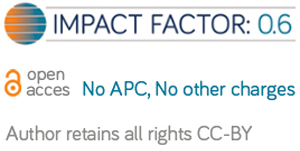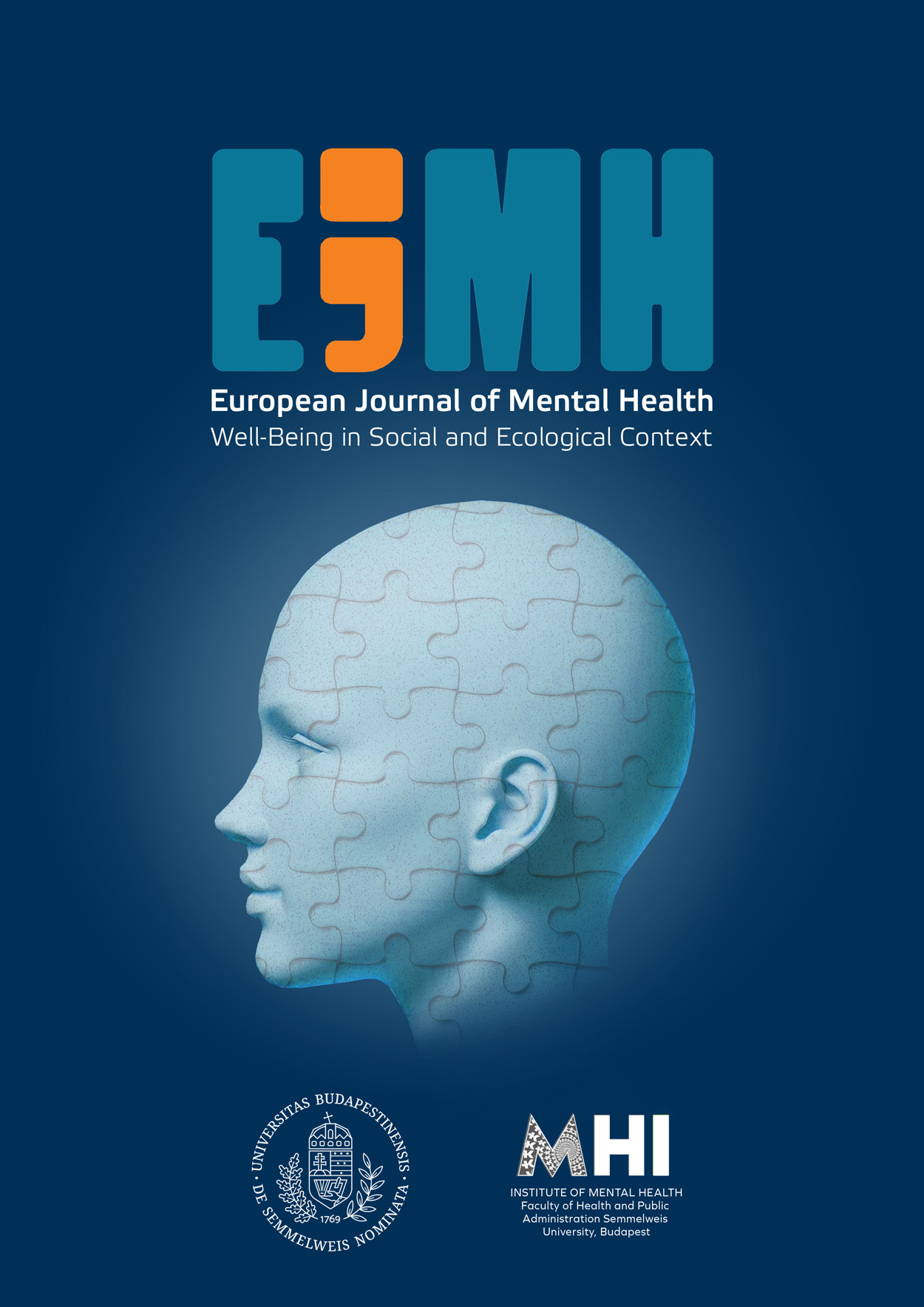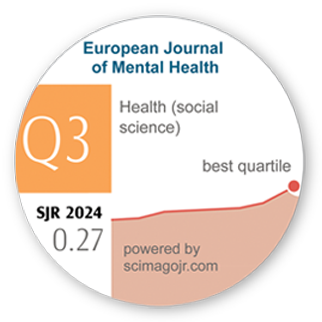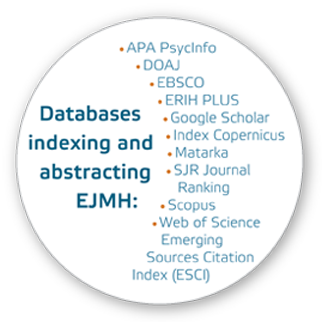Psychological Distress of High School Graduates During Social Distancing in Croatia
DOI:
https://doi.org/10.5708/EJMH.17.2022.2.4Keywords:
high school graduates, psychological distress, COVID-19, self-regulated learning, State Matura examsAbstract
Introduction: The COVID-19 pandemic has influenced the whole world, thus also affecting the high school graduates in Croatia.
Aims: The purpose of the study was to examine the psychological distress high school graduates experienced during the COVID-19 social distancing measures, more precisely to investigate gender and school type differences and to examine the relationship between psychological distress and self-regulated learning.
Methods: In this cross-sectional study, an online questionnaire was administered to 13,037 high school graduates across Croatia.
Results: The results show that girls exhibit higher levels of psychological distress compared to the boys, while the art school graduates show the highest distress, followed by gymnasium (i.e., secondary grammar school, prep school) graduates, and lastly vocational school graduates. Furthermore, a moderate negative correlation was found between self-efficacy and psychological distress, and significant, but small correlations were found between regulation of effort, management of work, time and environment, self-handicapping as well as elaboration and psychological distress. These results show that higher levels of self-regulation are connected to lower levels of psychological distress.
Conclusions: These findings demonstrate that a need exists for greater accessibility of mental health care for adolescents.
References
Bandura, A. (1994). Self-efficacy. In V. S. Ramachaudran (Ed.), Encyclopedia of human behavior (Vol. 4, pp. 71–81). New York: Academic Press.
Bandura, A. (2002). Social cognitive theory in cultural context. Applied Psychology, 51(2), 269–290.
https://doi.org/10.1111/1464-0597.00092" href="https://doi.org/10.1111/1464-0597.00092">http://doi.org/10.1111/1464-0597.00092
Bandura, A. (2006). Adolescent development from an agentic perspective. In: F. Pajares & C. T. Urdan (Eds.), Self-efficacy beliefs of adolescents (pp. 1 – 43). Information Age.
Banks, J., & Smyth, E. (2015). ‘Your whole life depends on it’: Academic stress and high-stakes testing in Ireland. Journal of Youth Studies, 18(5), 598–616.
https://doi.org/10.1080/13676261.2014.992317
Biggs, A., Brough, P., & Drummond, S. (2017). Lazarus and Folkman’s psychological stress and coping theory. In: C. L. Cooper & J. C. Quick (Eds.), The handbook of stress and health: A guide to research and practice (chapter 21, pp. 349–364).
https://doi.org/10.1002/9781118993811.ch21
Britner, S. L., & Pajares, F. (2001). Self-efficacy beliefs, motivation, race, and gender in middle school science. Journal of Women and Minorities in Science and Engineering, 7(4).
https://doi.org/10.1615/JWomenMinorScienEng.v7.i4.10
Chen, F., Zheng, D., Liu, J., Gong, Y., Guan, Z., & Lou, D. (2020). Depression and anxiety among adolescents during COVID-19: A cross-sectional study. Brain, Behavior, and Immunity, 88, 36–38.
https://dx.doi.org/10.1016%2Fj.bbi.2020.05.061" href="https://dx.doi.org/10.1016%2Fj.bbi.2020.05.061">https://doi.org/10.1016/j.bbi.2020.05.061
Choudhary, F. R., Mahmood, A., & Khushnood, S. (2020). Measuring self-regulation of distance learners: A comparative study of science and arts students. International Journal of Distance Education and E-Learning, 5(2), 138–157.
https://doi.org/10.36261/ijdeel.v5i2.1048
Clemens, V., Deschamps, P., Fegert, J. M., Anagnostopoulos, D., Bailey, S., Doyle, M., Eliez, S., Hansen, A. S., Hebebrand, J., Hillegers, M. Jacobs, B., Karwautz, A., Kiss, E., Kotsis, K., Kumperscak, H. G., Pejovic-Milovancevic, M., Christensen, A. M. R., Raynaud, J.-P., Westerinen, H., & Visnapuu-Bernadt, P. (2020). Potential effects of" social" distancing measures and school lockdown on child and adolescent mental health. European Child & Adolescent Psychiatry, 29, 739–742.
https://doi.org/10.1007/s00787-020-01549-w
Connell, J., Barkham, M., Stiles, W. B., Twigg, E., Singleton, N., Evans, O., & Miles, J. N. V. (2007). Distribution of CORE–OM scores in a general population, clinical cut-off points and comparison with the CIS–R. British Journal of Psychiatry, 190(1), 69–74.
https://doi.org/10.1192/bjp.bp.105.017657
Ćurković, M., Košec, A., & Brečić, P. (2020). Stay home while going out – Possible impacts of earthquake co-occuring with COVID-19 pandemic on mental health and vice versa. Brain, Behavior, and Immunity, 87, 82–83.
https://doi.org/10.1016/j.bbi.2020.04.054
Ćurković, N. (Ed.) (2019). Statistička i psihometrijska analiza ispita državne mature u školskoj godini 2017./2018. [Statistical and psychometric analysis of State Matura in school year 2017/2018]. Nacionalni centar za vanjsko vrednovanje obrazovanja
https://www.ncvvo.hr/statisticka-i-psihometrijska-analiza-ispita-drzavne-mature-u-sk-god-2017-2018/
De Anda, D., Baroni, S., Boskin, L., Buchwald, L., Morgan, J., Ow, J., Gold, J. S., & Weiss, R. (2000). Stress, stressors and coping among high school students. Children and Youth Services Review, 22(6), 441–463.
https://doi.org/10.1016/S0190-7409(00)00096-7
Goetz, T., Nett, U. E., & Hall, N. C. (2013). Self-regulated learning. In: N. C. Hall & T. Goetz (Eds.), Emotion, motivation, and self-regulation: A handbook for teachers (pp. 123–166). Emerald Publishing.
Gray, J. A. (1990). Brain systems that mediate both emotion and cognition. Cognition & Emotion, 4(3), 269–288.
https://doi.org/10.1080/02699939008410799
Guessoum, S. B., Lachal, J., Radjack, R., Carretier, E., Minassian, S., Benoit, L., & Moro, M. R. (2020). Adolescent psychiatric disorders during the COVID-19 pandemic and lockdown. Psychiatry Research, 291, Article 113264.
https://doi.org/10.1016/j.psychres.2020.113264
Heissel, J. A., Adam, E. K., Doleac, J. L., Figlio, D. N., & Meer, J. (2021). Testing, stress, and performance: How students respond physiologically to high-stakes testing. Education Finance and Policy, 16(2), 183–208.
https://doi.org/10.1162/edfp_a_00306
Hu, X., & Yeo, G. B. (2020). Emotional exhaustion and reduced self-efficacy: The mediating role of deep and surface learning strategies. Motivation and Emotion, 44, 785–795.
https://doi.org/10.1007/s11031-020-09846-2
Jokić-Begić, N., Korajlija, A. L., Jurin, T., & Evans, C. (2014). Faktorska struktura, psihometrijske karakteristike i kritična vrijednost hrvatskoga prijevoda CORE-OM upitnika [Factor structure, psychometric properties and cut-off scores of the Croatian version of the clinical outcomes in routines evaluation – Outcome measure (CORE-OM)]. Psihologijske Teme, 23(2), 265–288.
https://psycnet.apa.org/record/2014-30239-005
Jones, E. A. K., Mitra, A. K., & Bhuiyan, A. R. (2021). Impact of COVID-19 on mental health in adolescents: A systematic review. International Journal of Environmental Research and Public Health, 18(5), Article 2470.
https://doi.org/10.3390/ijerph18052470
Kar, N. (2019). Depression in youth exposed to disasters, terrorism and political violence. Current Psychiatry Reports, 21, Article 73.
https://doi.org/10.1007/s11920-019-1061-9
Knopf, D., Park, M. J., & Mulye, T. P. (2008). The mental health of adolescents: A national profile, 2008. San Francisco, CA: National Adolescent Health Information Center.
Kouzma, N. M., & Kennedy, G. A. (2004). Self-reported sources of stress in senior high school students. Psychological Reports, 94(1), 314–316.
https://doi.org/10.2466/pr0.94.1.314-316
Kurtović, A., & Živčić Bećirević, I. (2012). Uloga svakodnevnih negativnih događaja u depresivnosti adolescenata [The role of everyday negative events in adolescent depression]. Društvena istraživanja: časopis za opća društvena pitanja, 21(3), (117), 671–691.
https://doi.org/10.5559/di.21.3.04
Kyriacou, C., & Butcher, B. (1993). Stress in year 11 school children. Pastoral Care in Education, 11(3), 19–21.
https://doi.org/10.1080/02643949309470842
Lončarić, D. (2014). Motivacija i strategije samoregulacije učenja: teorija, mjerenje i primjena [Motivation and self-regulated learning strategies: Theory, measurement and application]. Faculty of Teacher Education, University of Rijeka, Croatia.
Low, N. C., Dugas, E., O’Loughlin, E., Rodriguez, D., Contreras, G., Chaiton, M., & O’Loughlin, J. (2012). Common stressful life events and difficulties are associated with mental health symptoms and substance use in young adolescents. BMC Psychiatry 12, Article 116.
https://doi.org/10.1186/1471-244X-12-116
Marques de Miranda, D., da Silva Athanasio, B., Sena Oliveira, A. C., & Simoese-Silva, A. C. (2020). How is COVID-19 pandemic impacting mental health of children and adolescents? International Journal of Disaster Risk Reduction, Article 101845.
https://doi.org/10.1016/j.ijdrr.2020.101845
Mikić, Z. K., Begić, N. J., & Bunjevac, T. (2012). Zdravstvene teškoće i izvori zabrinutosti adolescenata tijekom prilagodbe na srednju školu [Health difficulties and sources of concern for adolescents during adjustment to high school.] Psihologijske Teme, 21(2), 317–336.
https://hrcak.srce.hr/89532
Olejnik, S., & Algina, J. (2003). Generalized Eta and Omega Squared statistics: Measures of effect size for some common research designs. Psychological Methods, 8(4), 434–447.
https://doi.org/10.1037/1082-989X.8.4.434
Ostrov, E., Offer, D., & Howard, K. I. (1989). Gender differences in adolescent symptomatology: A normative study. Journal of the American Academy of Child & Adolescent Psychiatry, 28(3), 394–398.
https://doi.org/10.1097/00004583-198905000-00016
Pačić-Turk, L., Ćepulić D.-B., Haramina, A., & Bošnjaković, J. (2020). Povezanost različitih psiholoških čimbenika s izraženosti stresa, anksioznosti i depresivnosti u zdravstvenih djelatnika tijekom pandemije bolesti COVID-19 u Republici Hrvatskoj [Relationship of various psychological factors with the degree of stress, anxiety and depression in health professionals during the COVID-19 pandemic in the Republic of Croatia]., Suvremena Psihologija, 23, 35–53
https://www.bib.irb.hr/1104428
Pekrun, R. (2013). Emotion, motivation, and self-regulation: Common principles and future directions. In: N. C. Hall & T. Goetz (Eds.), Emotion, motivation, and self-regulation: A handbook for teachers (pp. 167–188). Emerald Publishing.
Pomerantz, E. M., Altermatt, E. R., & Saxon, J. L. (2002). Making the grade but feeling distressed: Gender differences in academic performance and internal distress. Journal of Educational Psychology, 94(2), 396–404.
https://doi.org/10.1037/0022-0663.94.2.396
Putwain, D. W. (2009). Assessment and examination stress in Key Stage 4. British Educational Research Journal, 35(3), 391–411.
https://doi.org/10.1080/01411920802044404
Qiu, J., Shen, B., Zhao, M., Wang, Z., Xie, B., & Xu, Y. (2020). A nationwide survey of psychological distress among Chinese people in the COVID-19 epidemic: Implications and policy recommendations. Published correction appears in: General Psychiatry, 33(2), Article e100213corr1.
https://doi.org/10.1136/gpsych-2020-100213corr1
Schraml, K., Perski, A., Grossi, G., & Simonsson-Sarnecki, M. (2011). Stress symptoms among adolescents: The role of subjective psychosocial conditions, lifestyle, and self-esteem. Journal of Adolescence, 34(5), 987–996.
https://doi.org/10.1016/j.adolescence.2010.11.010
Smith, G. (2008). Does gender influence online survey participation? A record-linkage analysis of university faculty online survey response behavior. ERIC Document Reproduction Service No. ED 501717.
Smith, L., Sinclair, K. E., & Chapman, E. S. (2002). Students’ goals, self-efficacy, self-handicapping, and negative affective responses: An Australian senior school student study. Contemporary Educational Psychology, 27(3), 471–485.
https://doi.org/10.1006/ceps.2001.1105
Twigg, E., Barkham, M., Bewick, B. M., Mulhern, B., Connell, J., & Cooper, M. (2009). The young person’s CORE: Development of a brief outcome measure for young people. Counselling and Psychotherapy Research, 9(3), 160–168.
https://doi.org/10.1080/14733140902979722
Twigg, E., Cooper, M., Evans, C., Freire, E., Mellor‐Clark, J., McInnes, B., & Barkham, M. (2016). Acceptability, reliability, referential distributions and sensitivity to change in the Young Person’s Clinical Outcomes in Routine Evaluation (YP‐CORE) outcome measure: Replication and refinement. Child and Adolescent Mental Health, 21(2), 115–123.
https://doi.org/10.1111/camh.12128
Van Nguyen, H., Laohasiriwong, W., Saengsuwan, J., Thinkhamrop, B., & Wright, P. (2015). The relationships between the use of self-regulated learning strategies and depression among medical students: An accelerated prospective cohort study. Psychology, Health & Medicine, 20(1), 59–70.
https://doi.org/10.1080/13548506.2014.894640
Vedel, A. (2016). Big Five personality group differences across academic majors: A systematic review. Personality and Individual Differences, 92, 1–10.
https://doi.org/10.1016/j.paid.2015.12.011
West, P., & Sweeting, H. (2003). Fifteen, female and stressed: Changing patterns of psychological distress over time. Journal of Child Psychology and Psychiatry, 44(3), 399–411.
https://doi.org/10.1111/1469-7610.00130
Wilson, G. S., Pritchard, M. E., & Revalee, B. (2005). Individual differences in adolescent health symptoms: The effects of gender and coping. Journal of Adolescence, 28(3), 369–379.
https://doi.org/10.1016/j.adolescence.2004.08.004
World Health Organization. (2020). Adolescent mental health.
https://www.who.int/news-room/fact-sheets/detail/adolescent-mental-health
Zakon o odgoju i obrazovanju u osnovnoj i srednjoj školi [Law on Upbringing and Education in Primary and Secondary School]. Narodne novine, 64 (2020). Retrieved August 23, 2022 from
https://www.zakon.hr/z/317/Zakon-o-odgoju-i-obrazovanju-u-osnovnoj-i-srednjoj-%C5%A1koli
Zhang, C., Ye, M., Fu, Y., Yang, M., Luo, F., Yuan, J., & Tao, Q. (2020). The psychological impact of the COVID-19 pandemic on teenagers in China. Journal of Adolescent Health, 67(6), 747–755.
https://doi.org/10.1016/j.jadohealth.2020.08.026
Zhou S.-J., Zhang L.-G., Wang L.-L., Guo Z.-C., Wang J.-Q., Chen J.-C., Liu, M., Chen X., & Chen J.-X. (2020). Prevalence and socio-demographic correlates of psychological health problems in Chinese adolescents during the outbreak of COVID-19. European Child and Adolescent Psychiatry, 29, 749–758.
https://doi.org/10.1007/s00787-020-01541-4






